英语语法基础讲座
- 格式:doc
- 大小:156.00 KB
- 文档页数:43
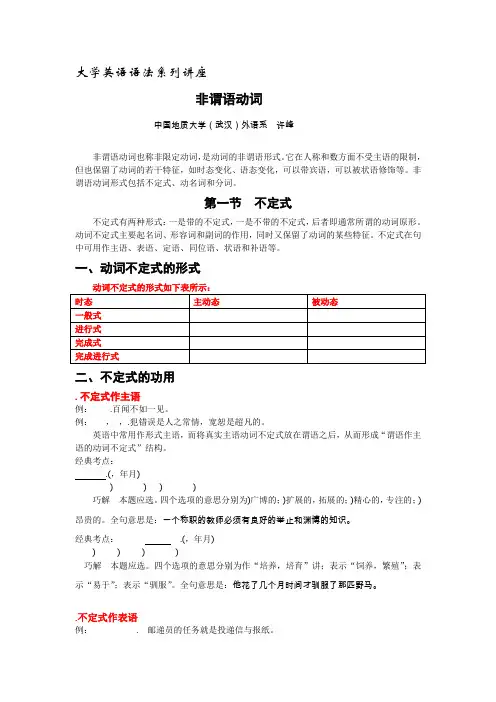
大学英语语法系列讲座非谓语动词中国地质大学(武汉)外语系许峰非谓语动词也称非限定动词,是动词的非谓语形式。
它在人称和数方面不受主语的限制,但也保留了动词的若干特征,如时态变化、语态变化,可以带宾语,可以被状语修饰等。
非谓语动词形式包括不定式、动名词和分词。
第一节不定式不定式有两种形式:一是带的不定式,一是不带的不定式,后者即通常所谓的动词原形。
动词不定式主要起名词、形容词和副词的作用,同时又保留了动词的某些特征。
不定式在句中可用作主语、表语、定语、同位语、状语和补语等。
一、动词不定式的形式动词不定式的形式如下表所示:二、不定式的功用.不定式作主语例:.百闻不如一见。
例:,,.犯错误是人之常情,宽恕是超凡的。
英语中常用作形式主语,而将真实主语动词不定式放在谓语之后,从而形成“谓语作主语的动词不定式”结构。
经典考点:.(,年月)) ) ) )巧解本题应选。
四个选项的意思分别为)广博的;)扩展的,拓展的;)精心的,专注的;)昂贵的。
全句意思是:一个称职的教师必须有良好的举止和渊博的知识。
经典考点:.(,年月))) ) )示“易于”;表示“驯服”。
全句意思是:他花了几个月时间才驯服了那匹野马。
.不定式作表语例:. 邮递员的任务就是投递信与报纸。
例:. 据说这本书已经翻译成了五种外语。
经典考点:' ,.(,年月)) )) )的意思为“始终,一直”,相当于,因此句中相应的动词一般要用进行式。
全句意思是:我宁愿看书也不愿看电视,电视节目好像越来越差了。
.不定式作宾语某些及物动词后可以用不定式作宾语,这些常考动词如下表:例:. 他们要求出示真实可靠的文件。
经典考点:'.(,年月)) )) ),后面应接动词不定式。
全句意思是:服务台那里有一个人,看上去很气愤,我想他是存心找麻烦。
经典考点:.(,年月)))))意为“收到”,均不合题意。
全句意思为:这对老夫妇虽然已有自己的三个儿女,但他们还是决定收养一儿一女。
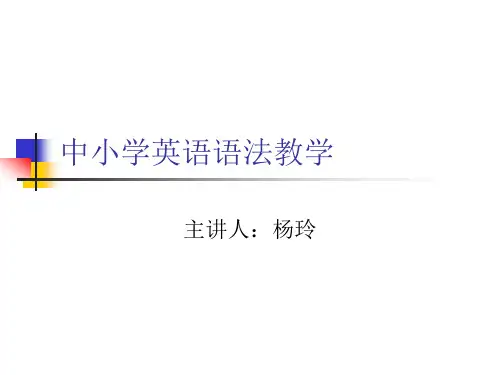
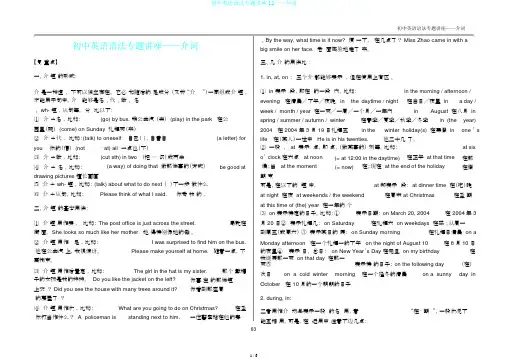
初中英语语法专题讲座——介词【复重点】一、介短的形式:介是一种虚,不可以独立存在。
它必和随后的足成分(又称“介”)一同组成介短,才能用于句中。
介能够是名、代、数、名、 wh- 短、从句等。
分比以下:⑴介+名,比如:(go) by bus 乘公共汽(去) (play) in the park 在公园里(玩) (come) on Sunday 礼拜天(来)⑵介+代,比如:(talk) to oneself 自己(),自言自(a letter) for you你的(信) (not⋯ at) all 一点也(不)⑶介+数,比如:(cut sth) in two (把⋯⋯切)成两半⑷介+名,比如:(a way) of doing that 做那件事的(方式)be good at drawing pictures 擅长画画⑸介+ wh- 短,比如: (talk) about what to do next ()下一步做什么⑹介+从句,比如:Please think of what I said.你考我的。
二、介短的基本用法:⑴介短用作表,比如: The post office is just across the street.局就在街面。
She looks so much like her mother. 她得特别像她的母。
⑵ 介短用作足,比如:I was surprised to find him on the bus.他在公共汽上,我很惊讶。
Please make yourself at home. 随意一点,不要拘束。
⑶ 介短用作后置定,比如:The girl in the hat is my sister.那个戴帽子的女孩是我的妹妹。
Do you like the jacket on the left?你喜左的那件短上衣? Did you see the house with many trees around it?你看到那座周的房屋了?⑷ 介短用作状,比如:What are you going to do on Christmas?在圣你打当作什么? A policeman is standing next to him.一位警察站在他的旁初中英语语法专题讲座——介词。
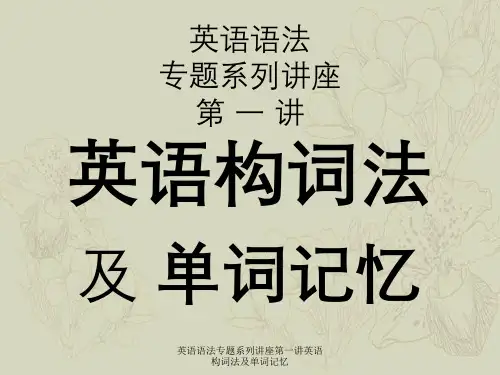
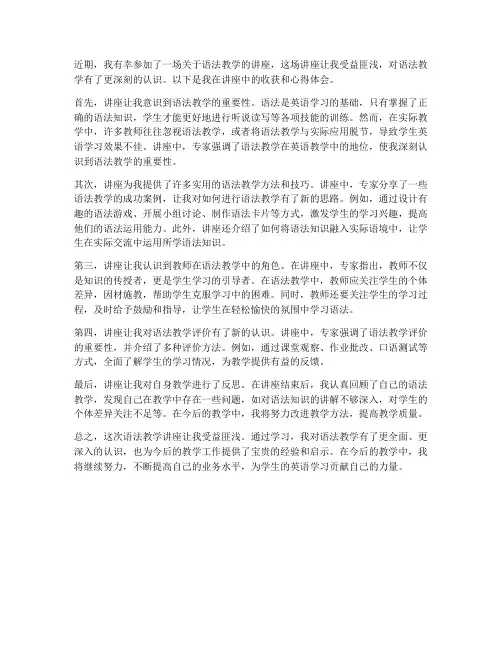
近期,我有幸参加了一场关于语法教学的讲座,这场讲座让我受益匪浅,对语法教学有了更深刻的认识。
以下是我在讲座中的收获和心得体会。
首先,讲座让我意识到语法教学的重要性。
语法是英语学习的基础,只有掌握了正确的语法知识,学生才能更好地进行听说读写等各项技能的训练。
然而,在实际教学中,许多教师往往忽视语法教学,或者将语法教学与实际应用脱节,导致学生英语学习效果不佳。
讲座中,专家强调了语法教学在英语教学中的地位,使我深刻认识到语法教学的重要性。
其次,讲座为我提供了许多实用的语法教学方法和技巧。
讲座中,专家分享了一些语法教学的成功案例,让我对如何进行语法教学有了新的思路。
例如,通过设计有趣的语法游戏、开展小组讨论、制作语法卡片等方式,激发学生的学习兴趣,提高他们的语法运用能力。
此外,讲座还介绍了如何将语法知识融入实际语境中,让学生在实际交流中运用所学语法知识。
第三,讲座让我认识到教师在语法教学中的角色。
在讲座中,专家指出,教师不仅是知识的传授者,更是学生学习的引导者。
在语法教学中,教师应关注学生的个体差异,因材施教,帮助学生克服学习中的困难。
同时,教师还要关注学生的学习过程,及时给予鼓励和指导,让学生在轻松愉快的氛围中学习语法。
第四,讲座让我对语法教学评价有了新的认识。
讲座中,专家强调了语法教学评价的重要性,并介绍了多种评价方法。
例如,通过课堂观察、作业批改、口语测试等方式,全面了解学生的学习情况,为教学提供有益的反馈。
最后,讲座让我对自身教学进行了反思。
在讲座结束后,我认真回顾了自己的语法教学,发现自己在教学中存在一些问题,如对语法知识的讲解不够深入,对学生的个体差异关注不足等。
在今后的教学中,我将努力改进教学方法,提高教学质量。
总之,这次语法教学讲座让我受益匪浅。
通过学习,我对语法教学有了更全面、更深入的认识,也为今后的教学工作提供了宝贵的经验和启示。
在今后的教学中,我将继续努力,不断提高自己的业务水平,为学生的英语学习贡献自己的力量。
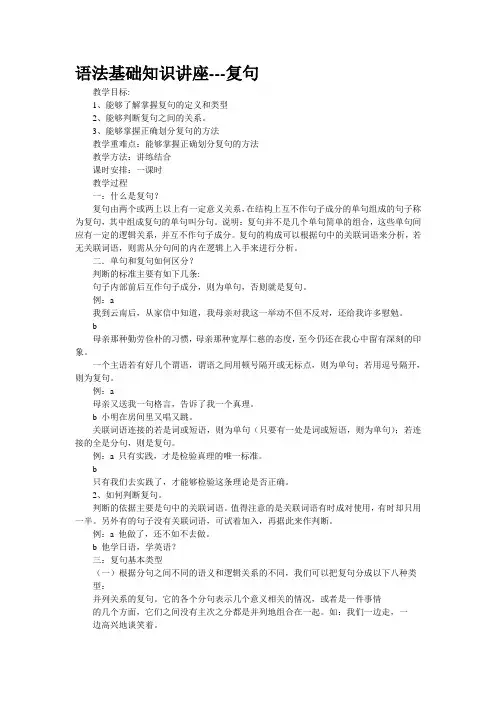
语法基础知识讲座---复句教学目标:1、能够了解掌握复句的定义和类型2、能够判断复句之间的关系。
3、能够掌握正确划分复句的方法教学重难点:能够掌握正确划分复句的方法教学方法:讲练结合课时安排:一课时教学过程一:什么是复句?复句由两个或两上以上有一定意义关系,在结构上互不作句子成分的单句组成的句子称为复句,其中组成复句的单句叫分句。
说明:复句并不是几个单句简单的组合,这些单句间应有一定的逻辑关系,并互不作句子成分。
复句的构成可以根据句中的关联词语来分析,若无关联词语,则需从分句间的内在逻辑上入手来进行分析。
二.单句和复句如何区分?判断的标准主要有如下几条:句子内部前后互作句子成分,则为单句,否则就是复句。
例:a我到云南后,从家信中知道,我母亲对我这一举动不但不反对,还给我许多慰勉。
b母亲那种勤劳俭朴的习惯,母亲那种宽厚仁慈的态度,至今仍还在我心中留有深刻的印象。
一个主语若有好几个谓语,谓语之间用顿号隔开或无标点,则为单句;若用逗号隔开,则为复句。
例:a母亲又送我一句格言,告诉了我一个真理。
b 小明在房间里又唱又跳。
关联词语连接的若是词或短语,则为单句(只要有一处是词或短语,则为单句);若连接的全是分句,则是复句。
例:a 只有实践,才是检验真理的唯一标准。
b只有我们去实践了,才能够检验这条理论是否正确。
2、如何判断复句。
判断的依据主要是句中的关联词语。
值得注意的是关联词语有时成对使用,有时却只用一半。
另外有的句子没有关联词语,可试着加入,再据此来作判断。
例:a 他做了,还不如不去做。
b 他学日语,学英语?三:复句基本类型(一)根据分句之间不同的语义和逻辑关系的不同,我们可以把复句分成以下八种类型:并列关系的复句。
它的各个分句表示几个意义相关的情况,或者是一件事情的几个方面,它们之间没有主次之分都是并列地组合在一起。
如:我们一边走,一边高兴地谈笑着。
承接关系的复句。
它的各个分句表示几个连续的动作,或者是先后发生的几种情况,它们之间是前后相接的。
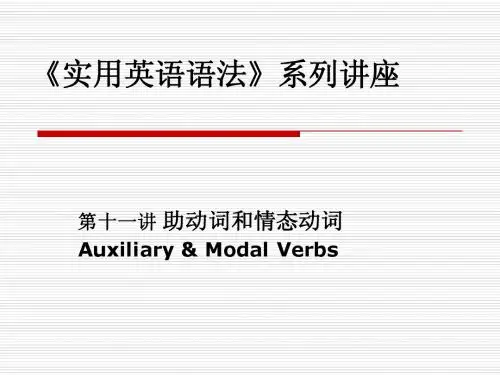
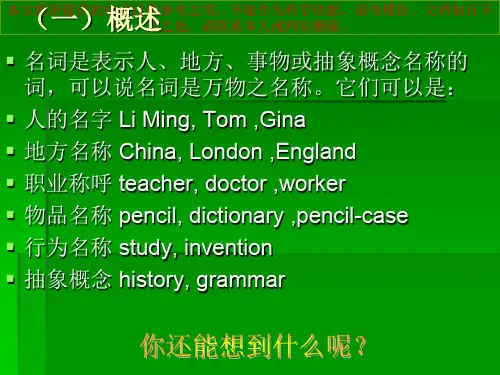
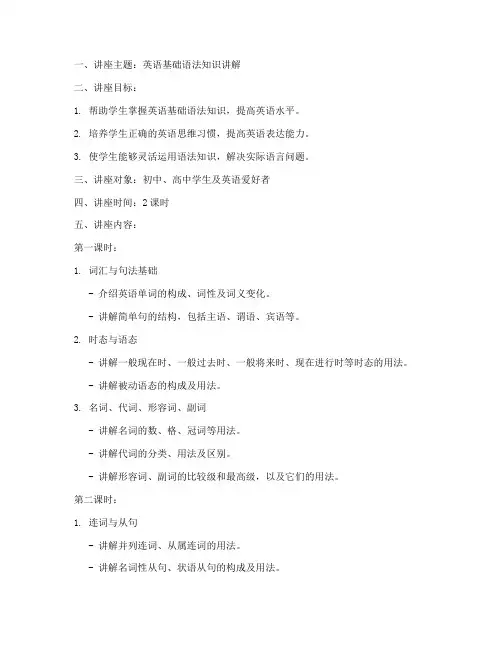
一、讲座主题:英语基础语法知识讲解二、讲座目标:1. 帮助学生掌握英语基础语法知识,提高英语水平。
2. 培养学生正确的英语思维习惯,提高英语表达能力。
3. 使学生能够灵活运用语法知识,解决实际语言问题。
三、讲座对象:初中、高中学生及英语爱好者四、讲座时间:2课时五、讲座内容:第一课时:1. 词汇与句法基础- 介绍英语单词的构成、词性及词义变化。
- 讲解简单句的结构,包括主语、谓语、宾语等。
2. 时态与语态- 讲解一般现在时、一般过去时、一般将来时、现在进行时等时态的用法。
- 讲解被动语态的构成及用法。
3. 名词、代词、形容词、副词- 讲解名词的数、格、冠词等用法。
- 讲解代词的分类、用法及区别。
- 讲解形容词、副词的比较级和最高级,以及它们的用法。
第二课时:1. 连词与从句- 讲解并列连词、从属连词的用法。
- 讲解名词性从句、状语从句的构成及用法。
2. 句子成分分析- 讲解主语、谓语、宾语、定语、状语、补语等句子成分的识别和作用。
3. 语法错误分析- 分析常见的语法错误类型,如时态错误、语态错误、主谓不一致等。
- 提供改正方法及练习。
六、教学方法:1. 讲授法:系统讲解语法知识,使学生掌握基本概念。
2. 练习法:通过大量练习,使学生巩固所学知识。
3. 案例分析法:结合实际例句,讲解语法知识,提高学生的实际应用能力。
七、教学评价:1. 课堂参与度:观察学生在课堂上的表现,如提问、回答问题等。
2. 课后作业:检查学生完成课后作业的情况,了解学生的学习效果。
3. 定期测试:通过测试,了解学生对语法知识的掌握程度。
八、讲座准备:1. 制作课件,内容包括语法知识讲解、例句、练习等。
2. 准备相关教材、参考资料。
3. 准备课堂互动环节,如小组讨论、角色扮演等。
九、讲座总结:1. 回顾本次讲座的主要内容,强调重点、难点。
2. 布置课后作业,巩固所学知识。
3. 鼓励学生在日常生活中运用所学语法知识,提高英语水平。


语法系列讲座之一名词与主谓一致I.名词的数名词可分为可数名词和不可数名词,可数名词有单复数形式。
名词的复数形式有两种,一种是规则复数,即在名词原形之后加-s或-es构成,如chairs, classes, stomachs, churches等;另一种是不规则复数,即不是在词尾加-s或-es构成复数,而是通过内部元音变换或其他方式构成,如tooth—teeth, woman—women, ox—oxen, mouse—mice等。
常用的单复数形式相同的名词:deer, means(方式,手段), Chinese, Japanese, series(系列), sheep, species(物种,种类), works(工厂), jin(斤), li(里), yuan(元)等。
应注意复合名词的复数:looker-on—lookers-on, grown-up—grown-ups, man (woman) servant—men (women) servants等。
总是表达复数概念的名词有:people(人们), police, poultry(家畜), cattle(畜群), mankind, womankind。
常见的不可数名词有:advice(建议), baggage, bread, cash(现金),equipment(设备,装备), furniture(家具), information, knowledge, luggage, money, news, traffic, trouble, work 等。
II.限定词与名词的搭配关系III.名词所有格的形式和用法名词所有格一般是在词尾加’s构成,如:the boy’s bag, my sister’s husband, our teacher’s room等。
如果原词已经有复数词尾-s则仅仅加一个(’)即可,如:boys’ school, students’ reading room等。
作为一名零基础学习者,我深知在语言学习中,语法的重要性。
近日,我有幸参加了一场关于零基础语法的讲座,通过这次讲座,我对语法有了更深入的了解,也收获了许多宝贵的经验和心得。
以下是我对这次讲座的心得体会。
一、讲座内容回顾本次讲座主要围绕以下几个方面展开:1. 语法基础概念:讲座首先介绍了语法的定义、作用以及在学习语言过程中的重要性。
2. 基本句型:讲座讲解了英语中的基本句型,如主谓宾结构、主系表结构等,并通过实例帮助学员理解和掌握。
3. 句子成分:讲座详细介绍了句子成分的种类、功能以及它们在句子中的作用,使学员对句子结构有了清晰的认识。
4. 词汇语法关系:讲座讲解了词汇与语法之间的关系,使学员明白词汇的正确运用离不开对语法的掌握。
5. 语法错误类型及纠正方法:讲座分析了常见的语法错误类型,并给出了相应的纠正方法,使学员能够避免这些错误。
6. 实践练习:讲座设置了多个练习环节,让学员在互动中巩固所学知识。
二、心得体会1. 语法是语言的基础通过本次讲座,我深刻认识到语法在语言学习中的重要性。
语法是语言的骨架,是语言表达的基础。
只有掌握了语法,我们才能正确地表达思想,使我们的语言更加规范、准确。
2. 基本句型是语法学习的关键讲座中提到的基本句型,如主谓宾结构、主系表结构等,是英语语法的基础。
通过学习这些基本句型,我们可以更好地理解句子结构,为后续学习打下坚实的基础。
3. 句子成分是理解句子结构的关键句子成分是构成句子的基本单位,掌握句子成分的种类、功能以及它们在句子中的作用,有助于我们更好地理解句子结构,提高语言表达能力。
4. 词汇与语法密不可分词汇和语法是相辅相成的。
在语言学习中,我们要注重词汇与语法的结合,才能使我们的语言表达更加地道、准确。
5. 语法错误类型及纠正方法至关重要讲座中提到的常见语法错误类型,如时态错误、语态错误等,是我们在学习过程中容易犯的错误。
通过了解这些错误类型及纠正方法,我们可以更好地避免这些错误,提高语言水平。
5.0 动词概要1)表⽰动作中状态的词叫做动词。
2)根据其在句中的功能,动词可分为四类,分别是:实义动词(Notional Verb)、系动词(Link Verb)、助动词(Auxiliary Verb)、情态动词(Modal Verb)。
说明:有些情况下,有些动词是兼类词,例如: We are having a meeting. 我们正在开会。
(having是实义动词。
) He has gone to New York. 他已去纽约。
(has是助动词。
)3)动词根据其后是否带有宾语,可分为两类,分别是:及物动词(Transitive Verb)、不及物动词(Intransitive Verb),缩写形式分别为vt. 和vi.。
说明:同⼀动词有时可⽤作及物动词,有时可⽤作不及物动词。
例如: She can dance and sing. 她能唱歌⼜能跳舞。
(sing在此⽤作不及物动词。
) She can sing many English songs. 她能唱好多⾸英⽂歌曲。
(sing⽤作及物动词。
)4)根据是否受主语的⼈称和数的限制,可分两类,分别是:限定动词(Finite Verb)、⾮限定动词(Non-finite Verb)例如: She sings very well. 她唱得很好。
(sing受主语she的限制,故⽤第三⼈称单数形式sings。
) She wants to learn English well. 她想学好英语。
(to learn不受主语she的限制,没有词形变化,是⾮限定动词。
说明:英语中共有三种⾮限定动词,分别是:动词不定式(Infinitive)、动名词(Gerund)、分词(Participle)。
5) 根据动词的组成形式,可分为三类,分别是:单字词(One-Word Verb)、短语动词(Phrasal Verb)、动词短语(Verbal Phrase)例如: The English language contains many phrasal verbs and verbal phrases. 英语⾥有许多短语动词和动词短语。
GotoPlayBoy初中英语语法专题讲座03 - 冠词初中英语语法专题讲座――冠词【复习要点】英语的冠词分为三种:不定冠词、定冠词和零冠词(即不用冠词)。
一、不定冠词:英语中不定冠词有两个:a, an。
a用于以辅音音素开头的词前,例如:a room, ared apple, a useful book;an用于元音音素开头的词前,例如:an egg, an old man, an hour。
1、不定冠词的基本用法:不定冠词主要用于泛指和类指,有时也用于特指(如以下第⑵条)。
⑴、表示“一个(one);每一个(each)”,例如:There is a table and four chairs in the room. 房间里有一张餐桌和四张椅子。
He comes to visit me twice a year. 他每年来看我两次。
a和one有时可以互换,例如:There were nearly a / one hundred people at the meeting.有将近100人参加了会议。
但是,在一些习惯用语中,a和one是不可互换的。
例如:once upon a time(从前)和one day(有一天)这两个短语中的a, one就不能互换;an hour or two 和one or two hours(一两个小时)这两个短语中的an, one也不能互换。
请注意:a (an) 虽表示“一个”,但不强调数量,而是强调类别;one则强调数量。
例:I bought a computer. 我买了一台电脑。
(不是收音机和电视机)I bought one computer. 我买了一台电脑。
(不是两台)⑵、表示“某一个(a certain)”,例如:She went to buy a dictionary. 他去买了一本词典。
(没有买别的东西)We used to live in a small house. 我们曾经住在一间小屋子里。
英语语法基础讲座时态——一般现在时一般现在时表示现在、经常或习惯的动作或状态和普遍现象、常识或客观真理;一般过去时用于过去某一时间内发生的或过去习惯性的动作或状态;一般将来时表示将要发生的动作或存在的状态,将来打算做的事情;现在完成时表示过去发生的动作造成目前的结果和对现在造成的影响或表示从过去延续至今的动作、状态和习惯等;将来完成时表示将来某时之前业已完成或发生的事情;过去完成时表示过去某时间之前已经发生的动作或状况,即过去的过去。
注意每一种时态与其他时态的交叉使用情况。
英语共有十六种时态,其表现形式如下(以study为例):(抱歉!我整理了半天也粘不上这个表格!哪位朋友想要这个表格,留言给我,我MAIL给你吧。
)考试中出现的一般有以下几种。
I、一般现在时一、表示一般性或经常发生的动作或状态1) In general [A],newspapers emphasize current news,whereas [B]magazines dealt [C]more with [D]background materials.2) The adult mosquito usually lives for about [A]thirty days,although [B]the life span varied [C]widely with temperature,humidity,and other [D]factors of the environment.3) Industrial buyers [A]are responsible [B]for supplying [C]the goods and services that an organization required [D]for its operations.二、表示习惯性动作和状态或普遍的现象或常识4) It is an accepted [A]custom in west countries that [B]men removed [C]their hats when a woman enters [D]the room.5) Certain layers of the atmosphere have special names .[A]which indicated their character properties[B]whose characteristic properties were indicating[C]what characterize their indicated properties[D]that indicate their characteristic properties三、表示客观事实、客观规律和客观真理。
在宾语从句中,即使主句的谓语动词用了过去时,只要从句表示的是客观真理,从句的谓语动词也要用一般现在时6) The teacher told them since [A]light travels faster than [B]sound, lightningappeared [C]to go before [D]thunder.7) As [A] a child, I was told that [B]the planet earth, which has [C]its own satellite, the moon, moved [D]round the sun.四、祈使句必须用动词原形,其否定结构用“don't+动词原形”,如:Go and fetch some water. /Don't do that.五、在反义疑问句中,如果主句用肯定句,那么,反问句用否定形式;如果主句用否定形式,那么,反问句就用肯定形式。
而且前后在时态上要一致。
但祈使疑问句用won't you?进行反问。
如:See a film tonight, won't you?注:①祈使句后边可用附加疑问句,以加强语气。
如果祈使句用肯定形式,附加疑问句用否定形式;如果祈使句用否定形式,附加句用肯定形式;如:Come here next Sunday, won't you? /Don't tell it to anyone, will you? ②但如果祈使句的前一句有了表示强烈[ZZ(]肯定[ZZ)]的语言环境,即使祈使句用了肯定形式,其附加成分也可以用“will you”(表示肯定,如果是在口语中用降调)。
如:Give me the book, will you?六、例题解析1) C错。
“in general”表示“一般”,所以主句用一般现在时,并列从句的谓语也是表示一般性,所以C处也应用一般现在时,故将其改为deal,而不是过去时dealt。
2) C错。
本句的主从句中的“usually”表示“经常”,用一般现在时;而让步状语从句的谓语也是表示同一情况,所以也应当用一般现在时。
故把C处的varied改为varies。
3) D错。
本句表述的是一般状况,前面的主句用的是现在时,后面的定语从句也应用现在时,应将required改为requires。
4) C错。
这里“it”是形式主语,代表主语从句“that…”,既然主句表示习惯(“an accepted custom”),那么谓语就应当用一般现在时,而不能用过去时。
所以将C处的removed改为remove。
5) D为正确答案。
本句表述的也是自然现象,主句和从句都应用一般现在时,故A和B 都不对;C不合语法,以“what”引导的从句不能作定语,只有D正确,这里“that”引导定语从句,修饰前边的名词“names”。
6) C错。
本句宾语从句所表述的是客观事实,即“…light travels faster than sound,”虽然主句谓语动词用的是过去式“told”,从句也要用一般现在时,所以把C处的appeared改为appears。
7) D错。
虽然主句的主语用了过去时“was told”,其宾语从句表示的是“地球绕着太阳转”这一客观规律,所以将D处的moved改为moves。
注意:不能将C处的has改为had,因为这也是表示客观事实,也得用一般现在时。
时态——一般过去时一般现在时表示现在、经常或习惯的动作或状态和普遍现象、常识或客观真理;一般过去时用于过去某一时间内发生的或过去习惯性的动作或状态;一般将来时表示将要发生的动作或存在的状态,将来打算做的事情;现在完成时表示过去发生的动作造成目前的结果和对现在造成的影响或表示从过去延续至今的动作、状态和习惯等;将来完成时表示将来某时之前业已完成或发生的事情;过去完成时表示过去某时间之前已经发生的动作或状况,即过去的过去。
注意每一种时态与其他时态的交叉使用情况。
英语共有十六种时态,其表现形式如下(以study为例):(表格同理,我不会别的办法,只能MAIL给各位啦。
)考试中出现的一般有以下几种。
II一般过去时一、一般过去时主要表示过去某一时刻发生的动作或情况,句中通常有表示过去某一时刻的状语a day ago, last week, in 1996, during the night, in anceint times等,表示“过多少时间之后”用after, 但在现在完成时中用in, 如in the past few years等1) How many people remember [A]listening [B]to Orson Welles' 1938 radio broadcast [C],“ The War of the Worlds”,which convince [D]thousands that space aliens(外星人) had invaded the Earth?2) The instructor had gone over [A]the problems many times [B]before [C]the students will take [D]the final examination.3) Anthropologists agree [A]that our primitive ancestors [B]who inhabit [C]the tropics probably have natural protection against [D]the Sun.二、例题解析1) D错,改用过去时convinced,因此处表述的是过去(1938年)所发生的情况,而现在则不是这样。
“which”引导的从句修饰“…1938 radio breadcast”。
2) D错。
由于主句使用的是过去完成时,表示在过去的某一动作发生之前,本句中的“before…”从句引导一个表示过去的时间状语。
所以状语从句的谓语应用过去时态,应把将来时“will take”改为一般过去时took,以便和主句的过去完成时呼应。
3) C错,改为inhabited,既然是“我们的祖先居住的热带地区”,“居住”这一动作发生在过去,所以要用过去时。
这里也要提醒大家:做语法题不仅要看特定的提示词如时间状语等,关键还在于读懂句子的意思。
如,虽然本句的主语还是同一表示过去的名词主语“primitive ancestors”,其谓语动词就用现在时“have”。
“我们的祖先有……”,这里的“有”,是现在我们看来的一种事实,所以用一般现在时。
时态——一般将来时一般现在时表示现在、经常或习惯的动作或状态和普遍现象、常识或客观真理;一般过去时用于过去某一时间内发生的或过去习惯性的动作或状态;一般将来时表示将要发生的动作或存在的状态,将来打算做的事情;现在完成时表示过去发生的动作造成目前的结果和对现在造成的影响或表示从过去延续至今的动作、状态和习惯等;将来完成时表示将来某时之前业已完成或发生的事情;过去完成时表示过去某时间之前已经发生的动作或状况,即过去的过去。
注意每一种时态与其他时态的交叉使用情况。
英语共有十六种时态,其表现形式如下(以study为例):(表格同理,不好意思。
)考试中出现的一般有以下几种。
III 一般将来时一、一般将来时表示将要发生的动作或状况1) But the weather experts [A]are now paying more attention to West Antarctic, which may be affected [B]by only a few degrees of warming: in other words, by a warming on the scale that would [C]possibly take place in the next fifty years from the burning [D]of fuels.(92年阅读理解题)2) If traffic problems are not solved soon [A],driving [B]in [C]cities becomes [D]impossible.二、在表示时间和条件的状语从句中,一般现在时代替一般将来时。